Geodemographics, GIS and Neighbourhood TargetingISBN: 978-0-470-86414-2
Paperback
328 pages
March 2005
 This is a Print-on-Demand title. It will be printed specifically to fill your order. Please allow an additional 10-15 days delivery time. The book is not returnable.
|
||||||
Preface.
1. Introducing Geodemographics.
Learning Objectives.
Introduction.
The use of demographics.
A simple application: opening a coffee shop Atlantic City.
Another application: for guiding neighbourhood regeneration funding.
Using geodemographics for retail targeting.
How it works: a short theory of geodemographics.
Case Study: modelling price sensitivity and geodemographic categories in the restaurant market (Martin Callingham).
Case Study: using geodemographics in the public sector Keith Dugmore).
Where next? An overview of the following chapters.
Conclusion.
Summary.
Further Reading.
2. London to Chicago and Back Again! The Origins of Geodemographics.
Learning Objectives.
Introduction.
The life and labours of an early neighbourhood analyst.
From London to Chicago and beyond!
A note on measuring deprivation.
Case Study: Charles Booth – yesterday once more? (Scott Orford).
Conclusion.
Summary.
Further Reading.
3. The Evolution of Geodemographics and the Market Today.
Learning Objectives.
Introduction.
From Census to commerce.
Geodemographics today.
The US Market for Geodemographics (Dave Miller).
The role of market research linkages.
Use of non-census data.
Conclusion.
Summary.
Further Reading.
4. Geodemographics and GIS.
Learning Objectives.
Introduction.
Principles of GIS.
Mapping geodemographic information with GIS.
An interesting pattern?
Confounded by choropleths!
Case Study: Using GIS for neighbourhood analysis and targeting – a commercial perspective (Stewart Berry).
Spatial interaction models.
Conclusion.
Summary
Further Reading.
5. Geodemographic Information Systems and Analysis.
Learning Objectives.
Introduction.
Data collection and input.
Data analysis.
Data visualization and output.
Case Study: Different neighbourhoods, different policing styles (Tom Williamson).
Conclusion.
Summary.
Further Reading.
6. How Geodemographic Classification are Built.
Learning Objectives.
Introduction.
Data input – sources of data for neighbourhood classification.
Preparing the data for classification.
Evaluation of input variables.
Selecting weights.
Clustering.
Optimization process and manual intervention.
Forming a cluster hierarchy.
Labels, portraits and visualization tools.
A worked example of clustering.
Conclusion.
Summary.
Further Reading.
7. Geodemographics Around the World.
Learning Objectives.
Introduction.
The internalisation of geodemographics.
Case Study: a brief comparison of selected censuses from across the world (Peter Furness).
Census data sources – some differences in what is asked and where.
Differences in the availability of non census data sources.
Variations in the detail of the postal delivery system.
International geographies of neighbourhood.
Conclusion.
Summary.
Further Reading.
8. 'But Does it Work? ' Geodemographics in the Dock.
Learning Objectives.
Introduction.
The case for the prosecution.
The case for the defence.
Validating geodemographics – the Luton Case Study (Barry Leventhal).
Conclusion.
Summary.
Further Reading.
9. New Data, New Approaches: from Geodemographics to Geolifestyles.
Learning Objectives.
Introduction.
Case Study: Lifestyles analysis and new approaches (Gordon Farquharson).
Using GIS to map lifestyle data.
Looking for ‘hot spots’.
From revelation to explanation.
Data handling issues.
Conclusion.
Summary.
Further Reading.
10. Postscript: There are three Is in geodemographics!
References.
Index.



